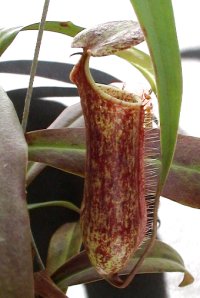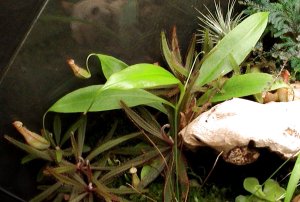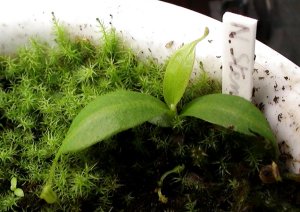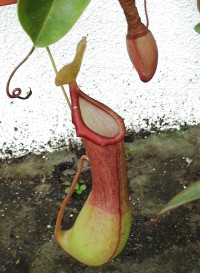NEPENTHES
After a first try I was deceived. Of course I tried to keep Nepenthes x coccinea in a flat that is nearly impossible. First difficulty was the lack of air humidity. There were trouble with light and temperature too. After I moved to a tropical country I tried again. Now it's okay, they are wonderful, never stop growing producing bigger and bigger pitchers. And they have just my veranda as a growing place.
Generally good cultivation conditions are warm and humid all year round. In their natural habitat there are only few variation between the different season and between night and day. Highland species require a little bit cooler nights. Most of them enjoy bright light but no direct sunlight. Finally their roots rot easily. They need a soil that drains water well and you will have to water them frequently.
- Nepenthes alata certainly one of the most common. Its pitchers have a rather elegant shape.
- Nepenthes fusca has very nice pitchers and seems to grow easily.
- Nepenthes gracilis is one of the smallest nepenthes. A fine one.
- Nepenthes madagascariensis I grow it from seeds, it takes much time.
- Nepenthes maxima has very nice and big red spotted pitchers.
- Nepenthes stenophylla is a highland nepenthes that seems to be easy.
- Nepenthes ventricosa very nice plant with same cultivation requirements as N.alata.
- Nepenthes X coccinea "red", one nepenthes said to be easy to cultivate and is fast growing.
- Nepenthes X ventrata very nice hybrid because of its shape and colours.
Nepenthes alata :
| Temp. (°C / °F) | Light | Climate | Origin | Remarks | |
| min. | max. | Half-shade | Tropical | Philippines, Sumatra and around | warm and humid all year round |
| 12 / 54 | 33 / 92 | ||||

 It's less sensitive to sun than N. x coccinea and can bear without any trouble few hours of direct sunlight. Its green pitchers become a bit red on their top. I grow it in a suspended pot and I water it one time a day even if there is high relative air humidity. It efficiently eat small insects as gnats (its pitchers are full of it) and sometimes flies. Compare to N. x coccinea, it attracts more insects in its traps, its leaves are smaller and its pitchers about the same size but narrower. There is no trouble with it. I let Mother Nature do its job and it works but be aware it's under subtropical weather conditions! As the plant grows I can see the pitcher's shape changing.
It's less sensitive to sun than N. x coccinea and can bear without any trouble few hours of direct sunlight. Its green pitchers become a bit red on their top. I grow it in a suspended pot and I water it one time a day even if there is high relative air humidity. It efficiently eat small insects as gnats (its pitchers are full of it) and sometimes flies. Compare to N. x coccinea, it attracts more insects in its traps, its leaves are smaller and its pitchers about the same size but narrower. There is no trouble with it. I let Mother Nature do its job and it works but be aware it's under subtropical weather conditions! As the plant grows I can see the pitcher's shape changing.
Nepenthes fusca :
| Temp. (°C / °F) | Light | Climate | Origin | Remarks | |
| min. | max. | Half-shade | Highland tropical | Borneo | warm and humid all year round |
| 12 / 54 | 33 / 92 | ||||
 As I grow them from seeds it takes time. If seeds were fresh enough they sprout easily. After one year I've lost some but hopefully some survive too. From photos I have seen the adult pitchers are very nice but I have to wait.
As I grow them from seeds it takes time. If seeds were fresh enough they sprout easily. After one year I've lost some but hopefully some survive too. From photos I have seen the adult pitchers are very nice but I have to wait.
Nepenthes gracilis :
| Temp. (°C / °F) | Light | Climate | Origin | Remarks | |
| min. | max. | Half-shade | Tropical | Borneo, Sumatra | warm and humid all year round |
| 18 / 65 | 33 / 92 | ||||

 It's the smallest of my adult nepenthes. It barely reaches 30 cm tall (1 foot) and its stem is easy to brake like dry wood. It happened one time but hopefully new shoots spread from the base of the plant. This nepenthes is rather sensitive to its environment variations. For example it really doesn't like winter's cold weather and summer's humidity drop down.
It's the smallest of my adult nepenthes. It barely reaches 30 cm tall (1 foot) and its stem is easy to brake like dry wood. It happened one time but hopefully new shoots spread from the base of the plant. This nepenthes is rather sensitive to its environment variations. For example it really doesn't like winter's cold weather and summer's humidity drop down.
Nepenthes madagascariensis :
| Temp. (°C / °F) | Light | Climate | Origin | Remarks | |
| min. | max. | Half-shade | Highland tropical | Madagascar | warm and humid all year round |
| 12 / 54 | 33 / 92 | ||||
 From seeds you'll have to be patient even if it's not the slowest grower. Even small its pitchers has an elongated shape that looks like the future adult ones. Till now there is no difficulty. It grows slowly but surely. After two years it starts becoming interesting. It is now more than 10 cm diameter (4 inches) and the pitchers are more and more shaped. Moreover it eats a lot of the ants that invaded my terrarium.
From seeds you'll have to be patient even if it's not the slowest grower. Even small its pitchers has an elongated shape that looks like the future adult ones. Till now there is no difficulty. It grows slowly but surely. After two years it starts becoming interesting. It is now more than 10 cm diameter (4 inches) and the pitchers are more and more shaped. Moreover it eats a lot of the ants that invaded my terrarium.
Nepenthes maxima :
| Temp. (°C / °F) | Light | Climate | Origin | Remarks | |
| min. | max. | Half-shade | Highland tropical | Borneo, New Guinea | warm and humid all year round |
| 12 / 54 | 33 / 92 | ||||
 It's a very easy one. It has flowered the first year perhaps because it was a cutting. I now know that's a male. Pitchers and the plant itself are rather big. It's impressive and very nice to look at.
It's a very easy one. It has flowered the first year perhaps because it was a cutting. I now know that's a male. Pitchers and the plant itself are rather big. It's impressive and very nice to look at.
Nepenthes stenophylla :
| Temp. (°C / °F) | Light | Climate | Origin | Remarks | |
| min. | max. | Half-shade | Highland tropical | Borneo | warm and humid all year round |
| 12 / 54 | 33 / 92 | ||||
 I did the seedling with those of N.fusca and results are near the same. I have to wait more.
I did the seedling with those of N.fusca and results are near the same. I have to wait more.
Nepenthes ventricosa :
| Temp. (°C / °F) | Light | Climate | Origin | Remarks | |
| min. | max. | Half-shade | Highland tropical | Philippines | warm and humid all year round |
| 12 / 54 | 33 / 92 | ||||
 Its cultivation is near the same as N.alata but it grows slower and dries easily. The middle of pitchers is thin which is a characteristic of this specie. That makes it easy to identify. Pitchers don't seem to live a long time no more than one season. Perhaps days running shorter and temperature going down make pitcher to dry out. Even if it's highland specie I think it's better to keep it as lowland one. That means keeping it warm during winter with the difference that cooler nights will be appreciated. It has done well like this. I have always some new pitchers and some flowers every years.
Its cultivation is near the same as N.alata but it grows slower and dries easily. The middle of pitchers is thin which is a characteristic of this specie. That makes it easy to identify. Pitchers don't seem to live a long time no more than one season. Perhaps days running shorter and temperature going down make pitcher to dry out. Even if it's highland specie I think it's better to keep it as lowland one. That means keeping it warm during winter with the difference that cooler nights will be appreciated. It has done well like this. I have always some new pitchers and some flowers every years.
Nepenthes X coccinea :
| Temp. (°C / °F) | Light | Climate | Origin | Remarks | |
| min. | max. | Half-shade | Tropical | Cultivation hybrid | warm and humid all year round |
| 18 / 65 | 33 / 92 | ||||

 It's an hybrid between N. x hookeriana and N. mirabilis, N. x hookeriana itself is a natural hybrid from N. ampullaria and N. rafflesiana. Now presentations are done! It is in a south oriented veranda but not in direct sunlight or no more than one hour a day in the morning. This family doesn't like blazing sun. I water it every morning, exceeded water fall down to the ground after it has gone through the compost. As I said before I live now under subtropical conditions (26° of latitude). In November temperature is always 77° F (nearly no day variations) and mean relative humidity about 80 %! In these conditions it's growing all the time and the pot is now too small. In a 9.45 inches of diameter pot there are 7 shoots and more than 30 pitchers with the biggest one about 4.72 inches long and 1.77 inches diameter! Pitchers seem to be very porous and sensitive to lower air humidity. Three days at 60 % were sufficient to dry few pitchers (the oldest ones). It doesn't like cold wheater too. During winter there were few days at 54°F that have stopped its growing for a while. It has grown again when temperature has reached 32°F with a high air humidity level too. It's sensitive and you can only see consequences long after something has changed.
It's an hybrid between N. x hookeriana and N. mirabilis, N. x hookeriana itself is a natural hybrid from N. ampullaria and N. rafflesiana. Now presentations are done! It is in a south oriented veranda but not in direct sunlight or no more than one hour a day in the morning. This family doesn't like blazing sun. I water it every morning, exceeded water fall down to the ground after it has gone through the compost. As I said before I live now under subtropical conditions (26° of latitude). In November temperature is always 77° F (nearly no day variations) and mean relative humidity about 80 %! In these conditions it's growing all the time and the pot is now too small. In a 9.45 inches of diameter pot there are 7 shoots and more than 30 pitchers with the biggest one about 4.72 inches long and 1.77 inches diameter! Pitchers seem to be very porous and sensitive to lower air humidity. Three days at 60 % were sufficient to dry few pitchers (the oldest ones). It doesn't like cold wheater too. During winter there were few days at 54°F that have stopped its growing for a while. It has grown again when temperature has reached 32°F with a high air humidity level too. It's sensitive and you can only see consequences long after something has changed.
Nepenthes X ventrata :
| Temp. (°C / °F) | Light | Climate | Origin | Remarks | |
| min. | max. | Half-shade | Highland tropical | Cultivation hybrid | warm and humid all year round |
| 12 / 54 | 33 / 92 | ||||
 It's an easy and interesting hybrid (Nepenthes ventricosa X Nepenthes alata). Pitchers really look like the parents' ones but they take a strong red colour from bottom to top that is not the case with N.alata or N.ventricosa. It produces numerous pitchers and shoots. There is no particular difficulty with this specie. After producing a long stem it has flowered. It's a female! I will be able to create my own hybrids.
It's an easy and interesting hybrid (Nepenthes ventricosa X Nepenthes alata). Pitchers really look like the parents' ones but they take a strong red colour from bottom to top that is not the case with N.alata or N.ventricosa. It produces numerous pitchers and shoots. There is no particular difficulty with this specie. After producing a long stem it has flowered. It's a female! I will be able to create my own hybrids.
Last modification on Saturday 08/02/2008
URL: http://gelinaud.free.fr/carni/pagdyn.php